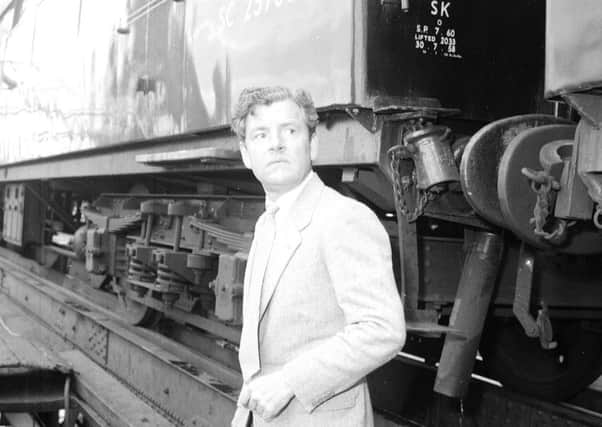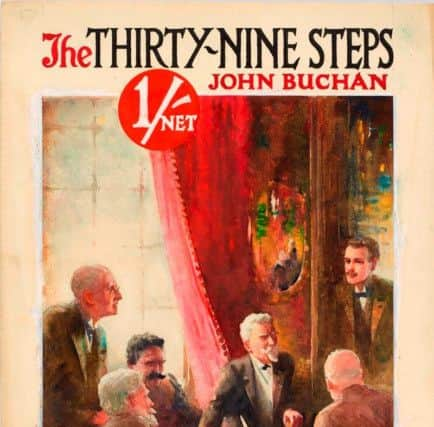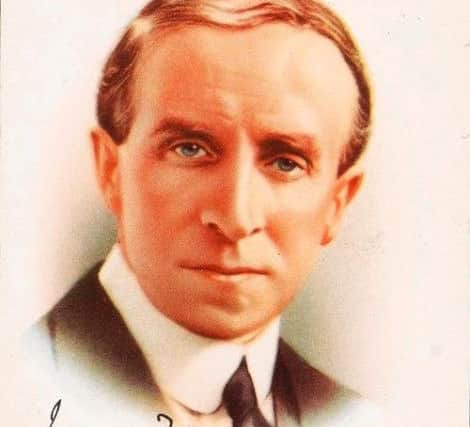Thirty-Nine Steps centenary marked at exhibition


And now, 100 years on, one of the most popular thrillers ever written is being celebrated with a fascinating exhibition revealing letters, a first edition, and the original typewritten film script of the subsequent Hitchcock adaptation of the book.
John Buchan’s The Thirty-Nine Steps is a classic man-on-the-run adventure story which has inspired countless film and radio adaptations over the years.
Advertisement
Hide AdThe book, set in the days leading to the outbreak of the First World War, is about the chase to unmask German spies before they escape with Britain’s military secrets.


It was written as a distraction by Buchan as he was recovering from illness in 1914.
“While pinned to my bed during the first months of war and compelled to keep my mind off too tragic realities, I gave myself to stories of adventure,” he wrote later.
On show in the National Library of Scotland display is a letter Buchan wrote to his publisher, George Blackwood, at the time.
He said: “I have amused myself in bed writing a shocker. It has amused me to write, but whether it will amuse you to read is another matter.”


The exhibition seeks to set the fictional story of The Thirty-Nine Steps in the Britain of the time by using a series of documents from that period, including railway maps which show how the main character, Richard Hannay, would have made his way from London to Galloway in the south-west of Scotland. Later, Hannay boards a train near Moffat, so visitors can take a look at a copy of Grieve’s penny guide to Moffat from 1904.
Advertisement
Hide AdThe display also includes cigarette cards of the stars of the 1935 Hitchcock adaptation of the book, Madeleine Carroll and Robert Donat, together with the film’s original script.
Hitchcock substantially re-wrote the story, introducing a female character and transferring some of the action to the Forth Bridge in one of the most famous scenes from the film.
Advertisement
Hide AdBuchan was an established writer of both fiction and non-fiction before he turned his hand to the escapist adventure story.
The Thirty-Nine Steps was published first as a serial in the summer of 1915 in Blackwood’s magazine under a pseudonym and in book form, under Buchan’s name, in October. It proved to be an immediate success with 33,000 copies being sold in the first three months.
“Buchan went on to write better novels, but the original tale of a man on the run from dark forces remains his most famous and has been hugely influential,” says Andrew Martin, curator for literature and the arts at the National Library, who has organised the display.
“It is said to have inspired Ian Fleming – the creator of James Bond – as well as Graham Greene and John Le Carre. There have been three major films, countless radio and television productions and a comedy spoof based on the book has just finished its stage run on London’s West End.”
He adds: “Thriller writing has become big business but very few, if any, of today’s books can ever hope to achieve the lasting appeal of The Thirty-Nine Steps.
“It has captured the imagination of generations of readers and continues to do so today, a century after its first publication.”
Advertisement
Hide AdBuchan was a prolific author throughout his career, writing histories and biographies as well as thrillers and historical novels.
During the First World War, he filled key roles at the War and Foreign Offices, and was appointed director of information. He made a major contribution with the innovative use of propaganda. As a journalist he also contributed to publications such as The Times and The Spectator.
Advertisement
Hide AdStarting in 1914, Buchan also wrote the extensive Nelson’s History of the War, producing initially 50,000 words for magazine instalments every two weeks.
In 1914, Buchan began writing about Richard Hannay and “the thirty-nine steps”. In 1916 and 1919, Buchan published the sequels Greenmantle and Mr Standfast, also featuring the Hannay. Alongside his novels, Buchan continued to write historical works, as well as becoming a trustee of the National Library of Scotland.
He went on to become Lord Tweedsmuir and took office as the Governor General of Canada from 1935 until his death in 1940.
As well as the most famous film adaptation, a colour film of The 39 Steps was released in 1959 starring Kenneth More and directed by Ralph Thomas. This was followed by another version starring Robert Powell in 1978. Both were filmed in Scottish locations.
The Thirty-Nine Steps – one hundred years on runs until November 22 at the National Library of Scotland, George IV Bridge. Entry is free.